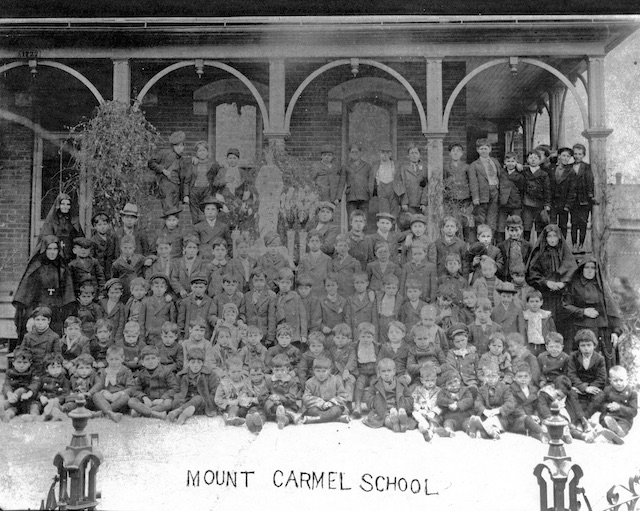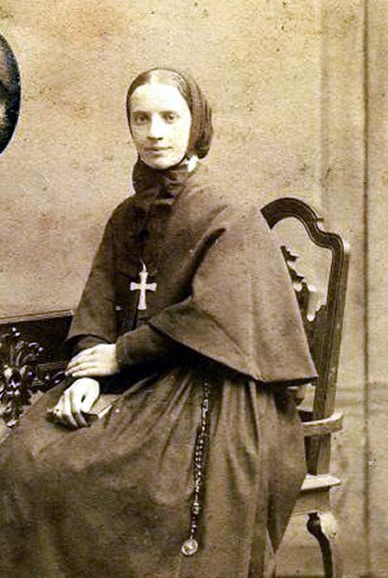Story
Celebrating Colorado Cabrini Day 2020
Despite the continuing pandemic, celebrations remain significant, even if remotely. They help us feel connected to our community, friends, and extended family. With the arrival of the inaugural Colorado Cabrini Day, we need to celebrate for a variety of reasons.
Here are five key reasons to celebrate Cabrini Day 2020:
1. To honor an amazing humanitarian
Dedicated to helping the poor and sick, Frances Xavier Cabrini had a lasting impact on the lives of the less fortunate worldwide. A mother to the masses, Cabrini’s work continues today via the many organizations bearing her name, both nationally and internationally. Following in Cabrini’s footsteps, these people-centered organizations work with and within communities addressing issues of health, nutrition, education, and protection as well as ensuring mental and spiritual wellbeing.
2. To acknowledge the impact of a woman’s life dedicated to the service of others, and by extension all women including those who have had an impact on your life
Colorado’s Cabrini Day is the first paid state holiday in the nation that recognizes a woman. For many, this means a day off: a day of freedom to celebrate yourself and the women in your life; those who came before you and those present today whose lives have afforded you opportunities and choices unparalleled just a generation ago.
3. To remember and show gratitude
We all come from somewhere. Many of us grew up in tight-knit communities and ethnic enclaves. Some of us are descendants of immigrants loved and cared for by Frances Xavier Cabrini herself. Today, the ethnic communities of the early and mid-twentieth century have transformed over time. A majority are now home to new cultures and residents from diverse social and economic backgrounds, including new immigrants to America. Like our ancestors, many in these new neighborhoods need help. Let Cabrini Day be an opportunity to give back to individuals and communities in need.
4. To look for what unites us while also celebrating and respecting our differences
America is built on a foundation of multi-ethnic, Indigenous, and immigrant generations. Although born from compromise and rooted in Italian American heritage, Cabrini Day offers all the opportunity to come together, reconnect, celebrate, and give back. With so much division in our world today, Cabrini Day affords us a chance to reset and celebrate a holiday dedicated to things that unite us, encourage us to find common ground, and call us to act with kindness and compassion in our community.
5. Because the smallest action can have a big impact
Let us all take a cue from Frances Xavier Cabrini and be kinder and more compassionate, and seek ways to improve the communities we live in!
Curious about the history of Cabrini Day? After various Colorado communities proposed the bill and advocated for it, Frances Xavier Cabrini House Bill 20-1031 passed in the Colorado Legislature on March 10 of this year. On Friday, March 20, Colorado Governor Jared Polis signed the bill into law, establishing Frances Xavier Cabrini Day as a Colorado state holiday. As the first paid state holiday in the nation that recognizes a woman, Cabrini Day will be observed in Colorado annually on the first Monday in October. The inaugural celebration takes place on October 5, 2020; in 2021 Cabrini Day is observed on October 4 and in 2022 on October 3.
So who was Frances Xavier Cabrini? The first American citizen canonized a saint in 1946 by the Catholic Church, Frances Xavier Cabrini was above all a remarkable humanitarian and considered one of Colorado’s most significant Italian Americans. She was born to farmers in Italy in 1850—the youngest of thirteen children—and was educated and trained to be a teacher. Her commitment to helping others led her to establish the order of The Missionary Sisters of the Sacred Heart in Rome in 1880, with the purpose of serving the poor, vulnerable, and those on the margins of society.
In 1899, Cabrini came to the United States to help Italian immigrants in Manhattan, the Bronx, and Brooklyn. A majority of these new arrivals were poor, illiterate, uneducated peasant farmers and unskilled laborers. While they came seeking opportunity, many found in America discrimination, unfair wages, and confusion regarding the American economic, legal, and political systems. To help these immigrants, Cabrini established schools, hospitals, orphanages, and social service outreach programs including English classes, recreational programs for children, sewing instruction for women as a means to earn money, and visits to hospitals, jails, and worksites to evaluate living conditions and the needs of the poor. Cabrini did all of these things primarily with volunteers and private donations.

In 1902, the Cabrini Missionary Sisters of the Sacred Heart opened a school in the carriage house of the Notary home. When it opened, it welcomed some 200 children—the daughters, sons, and grandchildren of Denver’s Italian immigrants. This school eventually became the Mount Carmel grade school and high school that operated until the 1960s. Although initially started for Italian Americans, the Mount Carmel schools welcomed children from diverse ethnic communities.

In October of 1904, the Cabrini Sisters established an orphanage at the Notary Home in North Denver. In 1905, Cabrini’s order moved the orphanage into a renovated farmhouse at 48th and Federal in Denver. The original Regina Coeli, or “Queen of Heaven” building was replaced in 1921 by the new facility seen in this image. The orphanage remained in operation until 1967.
At the request of Bishop Matz, Cabrini arrived in Colorado to help Denver’s Italian immigrants in 1902. Upon her arrival she was welcomed into the home of Michele and Rosina Notary, in the heart of Denver’s Little Italy. Here she established a convent, school, and orphanage. In time, these endeavors evolved into the Mount Carmel schools and the Queen of Heaven Orphanage.
In 1910, Frances Xavier Cabrini founded a summer camp for the Queen of Heaven orphans in Mount Vernon Canyon, west of Denver. Today known as Mother Cabrini Shrine, the site attracts thousands of visitors yearly. A place of prayer and meditation, the shrine is also a pilgrimage site for those seeking healing. Colorado’s shrine is one of three in the United States dedicated to Cabrini, with a second in New York and the third in Chicago.

Completed in 1914, the Stone House was used during the summer as a dormitory for the girls from the Queen of Heaven Orphanage who attended summer camp there until 1967. Today it’s a retreat facility and is listed in the National Register of Historic Places. Funds from the History Colorado State Historical Fund helped restore, renovate, and aid in the preservation of the Stone House.
In addition to her work in Colorado, New York, and Chicago, Frances Xavier Cabrini established institutions in New Jersey, Pennsylvania, Louisiana, Mississippi, Washington State, and California. She was a champion of immigrants and the poor. Frances Xavier Cabrini changed America. She gave Italian Americans—and others—access to education, health care, and social services. She helped people to better understand and care for themselves by providing them with tools and resources to better their lives, and they did. In turn, they contributed to American prosperity in countless ways.
Frances Xavier Cabrini died in Chicago in 1917, at the Columbus Hospital she helped open in 1896 to address the needs of Italian immigrants. The Columbus Hospital merged with Chicago’s Italian Hospital in 1973, and was renamed the Cabrini Health Care Center after Frances Xavier Cabrini. In keeping with the spirit of Cabrini’s legacy, the hospital was one of the earliest to treat and serve those suffering and dying from the AIDS epidemic in the 1980s.
Frances Xavier Cabrini’s work continues today through various organizations named after her and her commitment to education, personal development, and social justice. Schools, shrines, lodges, churches, and charity groups worldwide now honor Cabrini’s legacy by helping individuals and communities of all faiths, cultures, and backgrounds.
Ready to join the Cabrini Day 2020 celebration? If you’re interested in uplifting and uniting Colorado through kindness, compassion, and community-centered activities, just follow the steps below:
1. On Monday October 5, 2020 (when Colorado Cabrini Day is observed), start the celebration by taking the pledge:
Over the next four weeks, I, , in the spirit of Frances Xavier Cabrini, pledge to be kinder and more compassionate, and will work to improve the community I live in. I will also take time to care for myself and reflect upon the impact of my actions.
2. Next, print a downloadable flag to hang on your door, or a wallet card; carry this card with you as a reminder of your Cabrini Day pledge. Find the flag and card here: https://www.cabriniday.com/pledge-resources
3. Finally, print the Cabrini Day 2020 Action Calendar located here: https://www.cabriniday.com/pledge-resources
This calendar lists a small daily act to complete over four weeks. Complete the actions (or most of them) and enter your name at https://www.cabriniday.com/enter-drawing for the chance to win a Cabrini Day T-shirt—50 will be given away!
For more information visit https://www.cabriniday.com/
For further reading
Colorado Italian American Preservation Association (CIAPA) Archive. History Colorado. Stephen H. Hart Research Center/History Colorado Center, Denver, CO.
DiGiacomo, Alisa. Italy in Colorado: Family Histories from Denver and Beyond. Denver: History Colorado and The Donning Company Publishers, Third printing, 2018.
Sullivan, Mary Louise. “Mother Cabrini: Missionary to Italian Immigrants.” Catholic University of America Press, vol. 6, no. 4, The Italian American Community (Fall 1987), 265–279.
Mother Cabrini Shrine, Golden, Colorado https://www.mothercabrinishrine.org/ Note: Chicago and New York City also have Mother Cabrini Shrines.
Missionary Sisters of the Sacred Heart of Jesus, Pennsylvania https://www.mothercabrini.org/
St. Frances Cabrini Shrine, New York City https://cabrinishrinenyc.org/
The National Shrine of Saint Frances Xavier Cabrini, Chicago https://www.cabrininationalshrine.org/
Mother Cabrini Health Foundation, New York https://www.cabrinihealth.org/
Cabrini University, Pennsylvania https://www.cabrini.edu/


